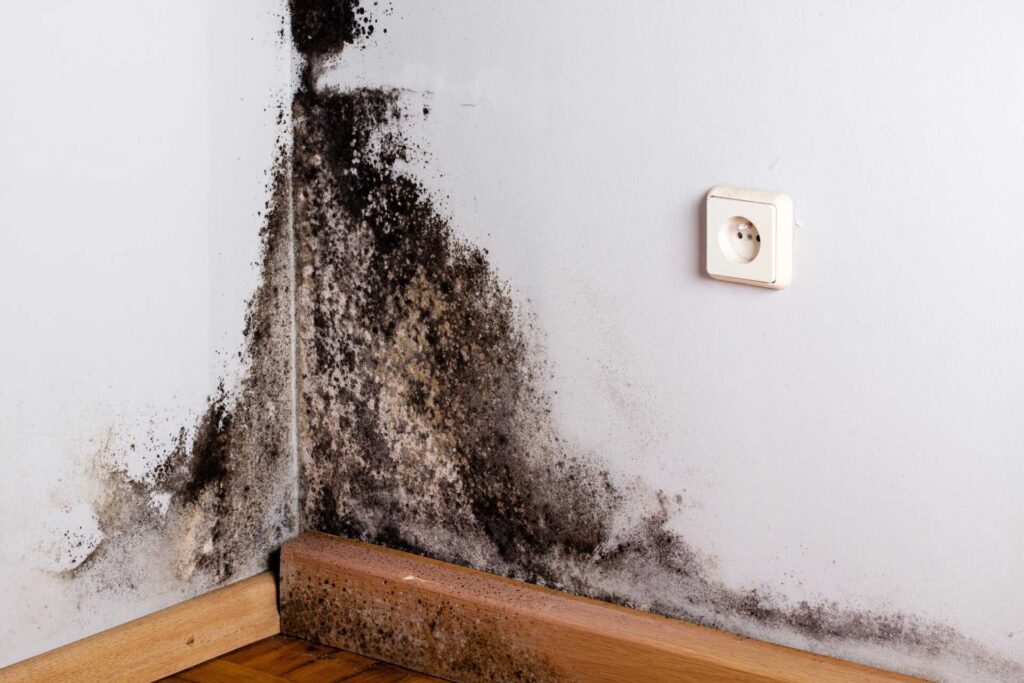
Contents
Preventing mold growth after water damage is vital, as mold can start to develop within 24 to 48 hours in the right conditions. Understanding the best strategies for mold prevention is crucial to safeguarding your home and health. By following seven essential tips, you can effectively minimize the risk of mold infestation and maintain a safe living environment. From prompt water extraction to utilizing mold-resistant materials, each step plays a significant role in combating mold growth. Be sure to explore these practical tips for thorough mold prevention after water damage.
Key Takeaways
- Swift water extraction to prevent mold growth.
- Thorough cleaning and disinfection of affected areas.
- Maintain humidity levels below 60%.
- Repair leaks promptly to prevent moisture buildup.
- Utilize mold-resistant materials for prevention.
Assessing Water Damage Extent
To effectively prevent mold growth after water damage, the first significant step is evaluating the scale of the water damage in your property. Begin by conducting a thorough leak detection process. Inspect common areas prone to leaks such as roofs, pipes, and windows. Look for signs of water stains, discoloration, or musty odors, which indicate hidden leaks. Identifying and fixing these leaks promptly is vital in preventing further damage and mold growth.
Next, move on to a detailed damage assessment. Check the extent of water infiltration and the affected areas. This includes visible water damage and areas where moisture may have seeped in, such as behind walls or under flooring. Use tools like moisture meters to detect hidden moisture pockets. Take note of any structural damage or weakening caused by the water.
It’s crucial to act swiftly and decisively during this assessment phase. The longer water damage lingers, the higher the risk of mold infestation. By thoroughly evaluating the scope of the water damage, you can create an effective plan for remediation and prevent mold from taking hold.
Prompt Water Extraction and Drying
To prevent mold growth after water damage, it’s essential to swiftly remove standing water from your property. Utilize efficient drying techniques like dehumidifiers and fans to thoroughly dry affected areas.
Quick Water Removal
Swift action is necessary when dealing with water damage to prevent mold growth. Quick water removal is crucial to lessen the risk of mold thriving in your home. Mold growth can start within 24-48 hours of water exposure, highlighting the urgency of prompt water extraction.
When facing water damage, promptly removing the water is vital to preventing mold from taking hold and spreading throughout your property. Water extraction involves using specialized equipment to swiftly and efficiently remove excess water from your space.
Efficient Drying Techniques
When facing water damage, your focus should shift to efficient drying techniques immediately after quick water removal. Proper drying is essential to prevent mold growth.
Start by strategically placing dehumidifiers in the affected area to reduce moisture levels. Dehumidifiers work by extracting excess moisture from the air, aiding in the drying process. Make sure that the dehumidifiers are placed in central locations for maximum efficiency.
Additionally, air movers can be utilized to enhance the drying process. Air movers help circulate air, speeding up evaporation and drying damp surfaces quickly. Position the air movers to create ideal airflow throughout the space, targeting wet areas directly. This will help prevent moisture from lingering and causing mold to develop.
Combining dehumidifiers and air movers creates a powerful drying system that effectively removes moisture from the environment. Remember that prompt and thorough drying is crucial in preventing mold growth after water damage occurs.
Prevent Moisture Buildup
Preventing moisture buildup is vital in the aftermath of water damage. To maintain a dry environment that discourages mold growth, prompt water extraction and drying are essential. Here are some key tips to prevent moisture buildup effectively:
| Dehumidifier Usage | Humidity Control |
|---|---|
| Use a dehumidifier to eliminate excess moisture from the air. | Keep indoor humidity levels below 60% to hinder mold growth. |
| Proper Drainage | Gutter Maintenance |
| Ensure adequate drainage around your property to avoid water accumulation. | Regularly clean and inspect gutters to prevent water seepage into the walls. |
| Ventilation | Insulation |
| Enhance air circulation by opening windows and utilizing fans. | Properly insulate walls, floors, and roofs to prevent condensation. |
Proper Ventilation and Air Circulation
Ensuring proper ventilation and air circulation in the affected area is essential to prevent mold growth after water damage. Proper ventilation helps in reducing moisture levels, which is vital for mold prevention. Here are some tips to improve ventilation and air circulation:
Install Fans: Utilize exhaust fans in bathrooms, kitchens, and any other areas prone to high humidity. These fans help in removing excess moisture from the air, reducing the chances of mold growth. Additionally, consider using ceiling fans to promote air circulation throughout the space.
Open Windows: When weather permits, open windows to allow fresh air to flow through the area. This can help in reducing humidity levels and expelling stale air, contributing to a healthier indoor environment. Make sure to open windows in different rooms to create cross-ventilation.
Air Purification Devices: Consider using air purifiers with HEPA filters to help remove mold spores and other impurities from the air. These devices can enhance indoor air quality, making it less conducive for mold growth. Place air purifiers strategically in areas with water damage for best results.
Thorough Cleaning and Disinfection
To combat potential mold growth in the aftermath of water damage, the focus now shifts towards the crucial step of thorough cleaning and disinfection. Proper ventilation is essential during this process. Make sure windows and doors are open to promote air circulation and prevent moisture buildup.
Start by removing any water-damaged items and debris from the affected area. Use a wet/dry vacuum to extract excess water, then clean surfaces with a mixture of detergent and water.
Effective disinfection is key to preventing mold. Use a solution of bleach and water (1 cup of bleach per gallon of water) to clean hard surfaces like floors, walls, and countertops. Remember to wear protective gear such as gloves and a mask when handling cleaning agents. Pay special attention to areas that were submerged in water, as they’re more vulnerable to mold growth.
After cleaning, thoroughly dry the area using fans and dehumidifiers. Monitor the humidity levels to make sure they stay below 60%. Regularly check for signs of mold regrowth and address them promptly.
Monitoring Humidity Levels Regularly
How important is it to monitor humidity levels regularly after water damage? In the aftermath of water damage, keeping a close eye on humidity levels is essential for preventing mold growth.
Here are some key steps to effectively monitor humidity levels and safeguard your home:
Utilize Dehumidifiers: Invest in a reliable dehumidifier to help maintain the best humidity levels in your home. Dehumidifiers work by extracting excess moisture from the air, reducing the risk of mold growth in damp areas.
Use Humidity Sensors and Moisture Meters: Place humidity sensors in different areas of your home to track and monitor humidity levels accurately. Additionally, moisture meters can be used to detect any hidden pockets of moisture that may contribute to mold growth.
Inspect for Damp Spots: Regularly check for damp spots or areas with visible moisture accumulation. These areas are prime breeding grounds for mold and should be addressed promptly to prevent further damage.
Inspecting and Repairing Leaks
Inspecting and repairing leaks is an important step in preventing mold growth after water damage. Proper leak detection is crucial to identify sources of excess moisture that can lead to mold development. Begin by thoroughly inspecting areas prone to leaks, such as plumbing fixtures, roofs, windows, and walls. Look for signs of water stains, discoloration, or musty odors, as these may indicate hidden leaks.
Repairing leaks promptly is crucial to prevent water from seeping into building materials and creating a conducive environment for mold. Whether it’s fixing a leaky pipe, sealing gaps in windows, or patching a damaged roof, addressing the source of water intrusion is key to mold prevention. Remember that even small leaks can result in significant water damage over time.
After repairing leaks, ensure that the affected areas are thoroughly dried to prevent mold growth. Utilize dehumidifiers and fans to expedite the drying process and maintain proper ventilation in the space. Monitor the repaired areas regularly to check for any signs of recurring leaks or moisture build-up.
Utilizing Mold-Resistant Materials
After taking the necessary steps to inspect and repair leaks in your property, the next important aspect of mold prevention involves utilizing mold-resistant materials.
Choosing the right materials can make a significant difference when preventing mold growth after water damage. Here are three key ways to utilize mold-resistant materials and enhance moisture control in your space:
Opt for Mold-Resistant Surfaces: Consider using materials that are specifically designed to resist mold growth, such as mold-resistant drywall, paint, and insulation. These surfaces have additives that inhibit mold growth even in damp conditions, making them ideal for areas prone to moisture.
Sealants and Coatings: Applying mold-resistant sealants and coatings to surfaces like wood, concrete, and metal can provide an extra layer of protection against mold. These products create a barrier that prevents moisture from seeping in, reducing the likelihood of mold development.
Ventilation Systems: Invest in proper ventilation systems for areas like bathrooms, kitchens, and basements to control humidity levels and prevent excess moisture buildup. Good ventilation helps to keep surfaces dry and inhospitable to mold growth.
Final Thoughts
Now that you’ve implemented these mold prevention strategies after water damage, you can rest assured that your home is on the path to recovery. But remember, the key to maintaining a mold-free environment lies in consistent monitoring and upkeep. So keep a vigilant eye on any signs of moisture or leaks, and continue to prioritize the health and safety of your indoor spaces. Stay proactive and stay mold-free.
Recent Posts
What Are Eco-Friendly Water Damage Repair Methods?
When it comes to addressing water damage in an environmentally friendly manner, eco-conscious methods are
7 Best Eco-Friendly Water Damage Repair Methods
When faced with water damage, you must consider the environmental impact of your repair methods.
Sustainable Water Damage Repair Techniques: A How-To Guide
When faced with water damage in your home, it’s crucial to explore sustainable repair techniques
